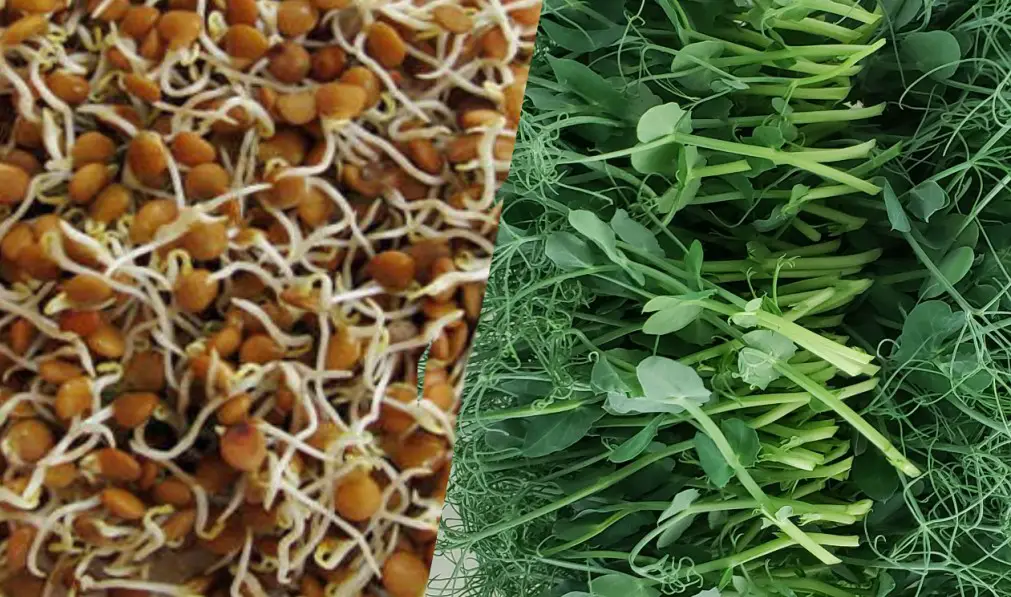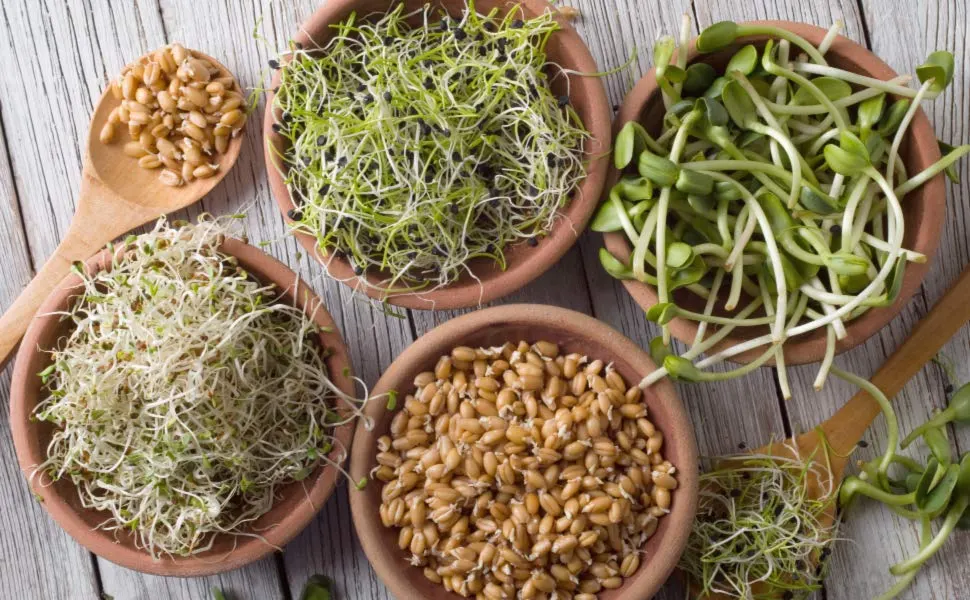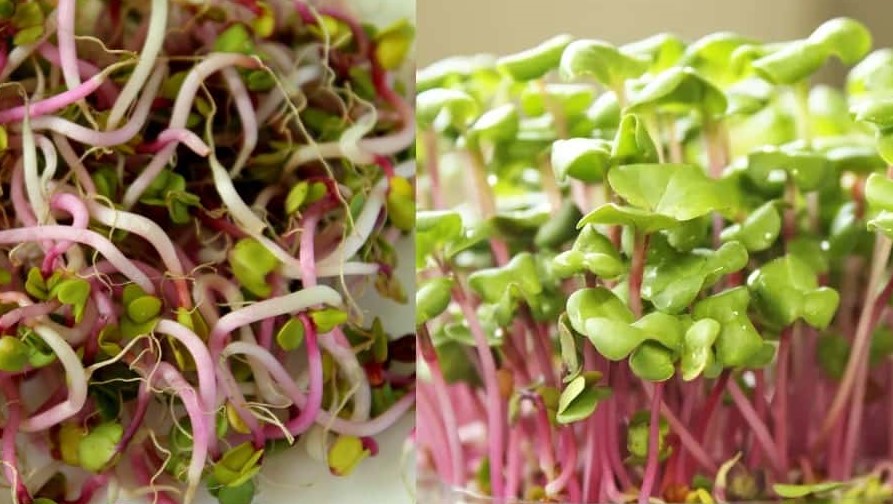Difference between microgreens and sprouts.
Microgreens and sprouts are both microforms of plants with high nutritional value that add a burst of flavor, taste, and extra nutrients to many dishes.
Now they can be found in a lot of grocery stores because researchers proved that young plants are healthier than their full-sized, mature counterparts.
Somehow, nowadays, the delusion that microgreens and sprouts are the same is commonly widespread. Despite these delusions, they are quite different from one another.
How do you know if the young plant is a microgreen or a sprout? Several properties will help you to distinguish them:

Microgreens vs. Sprouts
Growing medium
The microgreens are grown in a soil medium or in a soilless medium. The most common mediums are coconut coir, peat moss, and vermiculite.
Cultivating microgreens can grow even in a water environment. But this method is not used as frequently as others.
For further development and to “green up” microgreens need great air ventilation, sunlight (artificial or natural), or photosynthesis.
From time to time, while growing, germinated seeds have to get wet with the help of a spray bottle. For growing microgreens, supplemental heating or cooling makes the growing environment for baby greens better.
The growing medium for sprouts is hydroponic.
The hydroponic environment (in the water) rather than the soil is enough for sprouts ready to be cut to eat. This makes sprouts more affordable and available than microgreens.
Sprouts require a low light environment and intense humidity levels, but air ventilation does not matter that much.
Therefore, growing sprouts seem easier because they do not need extra nutrients from outside. Only nutrients stored in the sprouting seed are sufficient for their further growth.

Time to harvest
Microgreen seeds need from seven to twenty-one days after sowing to be ready for harvest. Harvesting of microgreens is possible only when their true leaves appear.
Sprouts grow quite rapidly, so they are ready for usage in a few days (exactly two to four days).
Within a week of germination, germinated seeds can be harvested in their seedling stage.
It is a big advantage of sprouting seeds because, during this period of harvesting two cycles of growing sprouts, you could let only one cycle of microgreens grow.

Harvesting method
After going through the period, when baby plant sprouts will be germinated, the next steps needed to be done: place them under indirect sunlight, rinse them with water, wipe them with paper towels, and put them through a salad spinner.
To cut off the harvested microgreens that were cultivated in the soil, you need to pull up the needed seed leaves with one hand and hold the stem with another to cut them off above the soil line.
Length
The length varies in the interval of 5-7 inches in harvesting microgreens, sprouts reach 2-3 inches tall.

Healthiness
Since the 1980s, sprouts have been widely accepted as a healthy food staple, especially alfalfa sprouts and mung bean sprouts because they were believed to have healing effects on Alzheimer’s and Parkinson’s diseases.
Both microgreens and sprouts have high nutrient content, but they have significant differences in nutrient profiles.
- Microgreens pack more nutritional value than sprouts. High levels of carotenoids, amino acids, and vitamins C, E, and K are stored in the microgreens.
- In comparison with sprouts, microgreens show more anti-diabetic and anticholinergic activity. As a result, it is almost miraculous that they could be used as an additional treatment for diabetes and other chronic diseases because they are not out of reach and can be obtained by anyone from grocery stores.
- Sprouts are affluent in proteins, enzymes, carbohydrates, and minerals.
- Sprouts have a high amount of antioxidant capacity because they are rich in polyphenols and L-ascorbic acid. Their prevalence is because they contain more amino acids, pectins, and sugars than microgreens.
However, eating raw sprouts is risky for health, in contrast to raw microgreens. Consumption of them, even accidentally, may lead to food poisoning with E. coli, salmonella, or listeria. They are a cause of foodborne illness outbreaks.
Raw diets with sprouts are not recommended for young children, pregnant women, or people with weak immune systems.

Diversity
Microgreens come in many varieties, while sprouts have limited varieties. The research shows more than 100 varieties of microgreens exist.
It allows for lots of varieties of baby greens to be harvested and makes them versatile.
While sprouting, seeds do not grow from every second vegetable or herb.

Sterility
The hydroponic, low light environment and bad air ventilation conditions make sprouts an ideal place for making colonizing bacteria grow.
Microgreens are safe from these probable circumstances because the growing medium of microgreens blocks the occurrence of foodborne illness.
The direct sunlight source prevents hazardous bacteria from further dividing.
Additionally, the researchers proved that these products have the highest nutrients: selected sprouts, such as broccoli, lentil sprouts, and mung bean sprouts, and selected microgreens, such as radish microgreens, kale, amaranth, sunflower microgreens, and red cabbage needed to be added in many dishes of any person as an addition to salads, sandwiches, etc.

Rules on how to eat microgreens vs. sprouts
Microgreens are not allowed to be eaten entirely: the region above the soil level is only cut off: not the seed, only the stem, and true leaves can be consumed.
The whole parts of growing own sprouts are allowed to eat: root, shoot, and seed leaves.

Results
TABLE: microgreens vs. sprouts
| General сoncepts | Microgreens | Sprouts |
| Growing medium | Soil, a soilless medium, water | Only in the water |
| Rules on how to eat | Only stem and true leaves | Entirely-root, shoot, stem |
| Harvesting period | 1-2 weeks | 2-3 days |
| Requirement for growing | Direct sunlight, great air ventilation | Only water |
| Diversity | 100 varieties | Limited varieties |
| Price | Expensive | Cheap |
FAQ
Which is better sprouts or microgreens?
If brought into account, that
Microgreens have more nutrients, fibers, vitamin C, anti-diabetic, and anti-cholinergic properties.
They do not create an ideal environment for the development of bacterial infections. They can be consumed in raw diets.
Microgreens have a stronger flavor and more varied textures.
I can suggest, that in the battle of microgreens vs. sprouts, microgreens are much healthier and safer. Such good news for people, who wanted to grow their own microgreens.
Are microgreens safer than sprouts?
Yes, they are. I mentioned, how risky eating raw sprouts are. While microgreens in any form can be eaten up and the person is aware, that these baby plants do not cause food poisoning in the future.
Can you grow sprouts as microgreens?
No. Sprouts need a special hydroponic environment, without air ventilation, and sunlight, but with high humidity.
Learn More: Growing Sprouts vs. Microgreens



